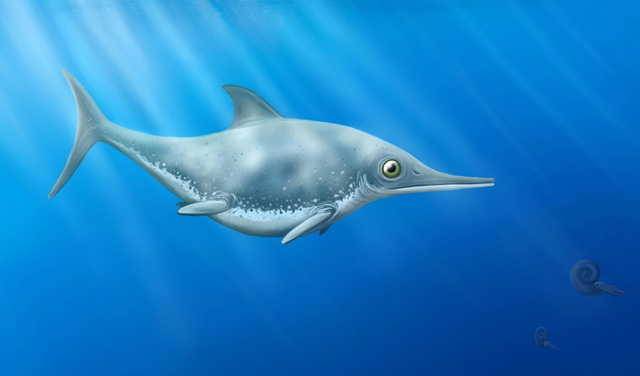Thalassodraco etchesi – A New Species of Ichthyosaur is Described
Thalassodraco etchesi – A New Species of Ichthyosaur is Described
A new kind of ichthyosaur has been named and described (Thalassodraco etchesi) following the discovery of a partial, articulated skeleton preserved in a limestone concretion on the Dorset coast (southern England). The fossil material consisting of the anterior portion of the marine reptile was discovered by renowned amateur fossil hunter Dr Steve Etches MBE, the founder of the Etches Collection museum, located on Kimmeridge Bay, not too far from where this new species was discovered.
This new species has been named Thalassodraco etchesi, the name translates as “Etches Sea Dragon”.
A Life Reconstruction of Thalassodraco etchesi
Picture credit: Megan Jacobs/University of Portsmouth
Unusual Dentition
Noticing the numerous, small teeth in the jaws, there are more than seventy teeth in the upper jaws alone, Steve passed his find onto researchers at the University of Portsmouth. The scientific paper on the fifth known ichthyosaur from the Late Jurassic has been published in the on-line, open-access journal PLOS One.
Corresponding author of the paper, University of Portsmouth Masters student, Megan Jacobs, comments that at an estimated two metres in length, it is the smallest ichthyosaur from the Late Jurassic to be described to date.
The location of the fossil discovery – Kimmeridge Bay is part of the Jurassic Coast World Heritage Site. The material comes from a limestone layer known as the White Stone Band. When it died, the seafloor would have been a very soft ooze, allowing the front half of the animal to sink into the mud, before scavengers came along and ate the tail end.
The Beautifully Prepared Fossilised Remains of T. etchesi with an Interpretative Line Drawing

Picture credit: Jacobs and Martill (with permission to use the photograph from the Etches Collection)
As the anterior portion of the carcass was partially buried it was protected from being scavenged and the fine particles of mud which encased it provided conditions for exceptional preservation. Stomach contents along with ligaments and some other soft tissues have been preserved.
Commenting on the specimen, Megan stated:
“Skeletons of Late Jurassic ichthyosaurs in the UK are extremely rare, so, after doing some research, comparing it with those known from other Late Jurassic deposits around the world, and not being able to find a match was very exciting. Thalassodraco etchesi is a beautifully preserved ichthyosaur, with soft tissue preservation making it all the more interesting. Steve’s incredible collection contains many new and exciting animals, and being given the chance to describe this ichthyosaur was a real privilege.”
A Deep Body but Small Forelimbs
The researchers noted the unusual body shape of the small ichthyosaur, it had a deep ribcage, small forelimbs and jaws lined with dozens of tiny, conical teeth. It may have filled a slightly different niche in the Late Jurassic marine ecosystem compared to other ichthyosaurs.
Co-author of the paper, Professor David Martill, who leads the vertebrate palaeontology research unit at the University of Portsmouth commented:
“Steve is an exceptional fossil collector and although he is sometimes referred to as an amateur collector, he has done so much for palaeontology that he has been awarded an MBE, and is truly a pro. If it were not for collectors like Steve, scientists would have very few specimens to work on.”
A Skeletal Reconstruction of Thalassodraco etchesi
Picture credit: Jacobs and Martill (PLOS One)
With the publication of the scientific paper formally naming this new species of marine reptile, the research does not end. The team hope to study the specimen, which is part of the Etches Museum collection, learning more about the reptile’s biology.
Professor Martill explained:
“There are a number of things that make this animal special, not least of which is its unusual rib cage and small flippers. It may have swum with a distinctive style from other ichthyosaurs.”
Our congratulations to Dr Steve Etches and all the team at the amazing Etches Collection museum on the Dorset coast.
The scientific paper: “A new ophthalmosaurid ichthyosaur from the Upper Jurassic (Early Tithonian) Kimmeridge Clay of Dorset, UK, with implications for Late Jurassic ichthyosaur diversity” by Megan L. Jacobs and David M. Martill published in PLOS One.
Visit the Everything Dinosaur website: Everything Dinosaur.



